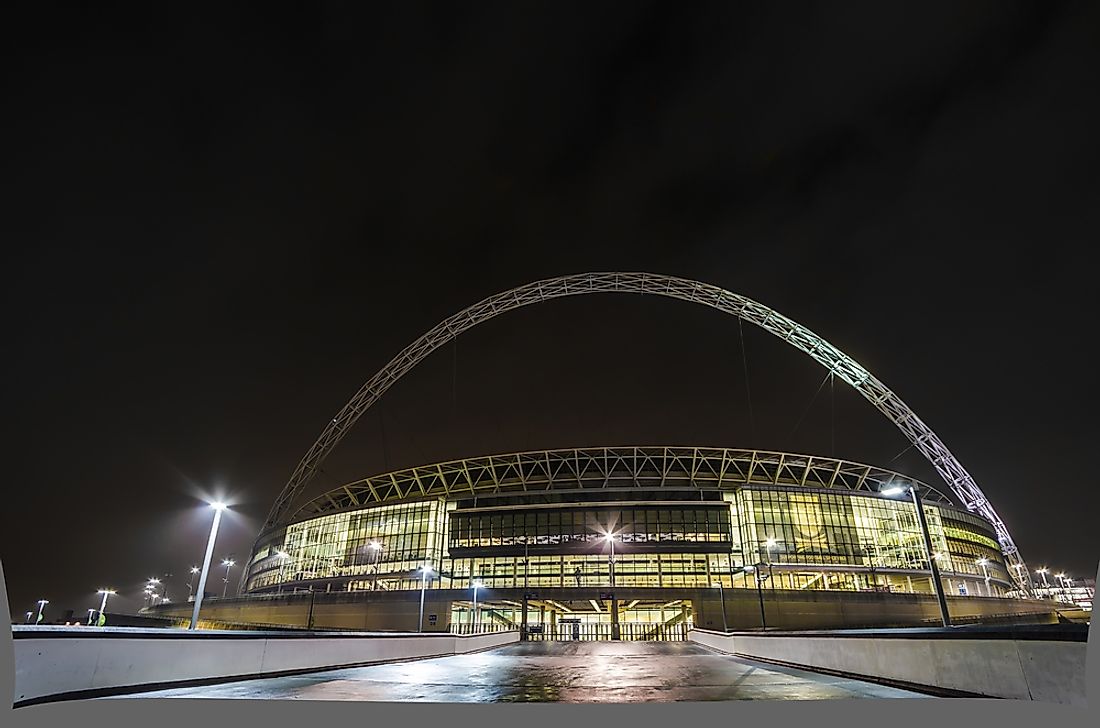The Largest Stadiums In The United Kingdom

Stadiums gained popularity in the United Kingdom during the late Victorian era fueled by the growth of organized sports. The nation got its first modern stadium in 1872 named the Lansdowne Road Stadium. Since then, many stadiums have been built across the country, some of which are very large.
Wembley Stadium
Construction of the Wembley Stadium in Wembley, London began in 2003 and ended in 2007. The England national football team occupies the 90,000 capacity stadium as a tenant. The stadium replaced the original Wembley Stadium which had been built in 1923. It holds the title of the largest stadium in both England and the UK. In Europe, the stadium trails behind Camp Nou Stadium in Barcelona which has a capacity of 99,354. The Football Association retains the stadium’s ownership. Wembley Stadium is famous as a host for the English Football league, and it was the host of the UEFA Champions League Finals in 2011 and 2013. Muse and the Green Day are some of the musical performances that have been held to entertain fans in the stadium.
Twickenham Stadium
The Twickenham Stadium was built between 1907 and 1909 in Twickenham, London. It boasts a capacity of 82,000 to be Europe’s fourth largest stadium. The Rugby Football Stadium oversees the stadium’s operations in its capacity as its owner. Twickenham Stadium hosts almost all games of the England national rugby union team. Several local and international rugby union games are held in the Stadium as well as the yearly London tournaments of the World Rugby Sevens Series. The Stadium also hosts other significant events such as The Varsity Match which pits Oxford and Cambridge in rugby games and the local Middlesex Sevens competition.
Old Trafford
The Old Trafford Stadium is situated in Manchester, and it was built from 1909 to 1910. Its capacity of 75,731 makes it Europe’s 11th largest stadium. The stadium is owned by the Manchester United Club which has occupied it since its completion. Between 1941 and 1949, the club shared the stadium with Manchester City due to damage from World War II bombs. The stadium has hosted important games throughout history including matches of the Summer Olympics in 2012 and the 1996 World Cup. The Stadium had a record attendance of 76,962 in 1939 when the FA Cup semi-final was played between Grimsby Town and Wolverhampton Wanderers.
Principality Stadium
The Principality Stadium is a landmark in Cardiff, Wales. It is also known as the Millennium Stadium, and it has a capacity of 74,500. The stadium was built from 1997 to 1999 to host matches of the 1999 Rugby World Cup. It made history as Europe’s second stadium to have a retractable roof. The stadium tenants are the Welsh Rugby Unions and the Football Association of Wales. Six FA Cup finals have been held in the stadium as well as the finals for the Heineken Cup, Rugby League Challenge Cup, and League Cup.
Uses Of Stadiums In The UK
The majority of the country’s stadiums are used for association football while others host a variety of sports from cricket, rugby, athletics, tennis, American football, camogie, Speedway, and greyhound hunting. Music concerts, art and cultural showcases, and community events are also sometimes hosted in the stadiums.
Which Are The Largest Stadiums In The United Kingdom?
| Rank | Stadium | Capacity | Location |
|---|---|---|---|
| 1 | Wembley Stadium | 90,000 | London |
| 2 | Twickenham Stadium | 82,000 | London |
| 3 | Old Trafford | 75,731 | Manchester |
| 4 | Principality Stadium | 74,500 | Cardiff |
| 5 | Murrayfield Stadium | 67,144 | Edinburgh |
| 6 | London Stadium | 66,000 | London |
| 7 | Emirates Stadium | 60,432 | London |
| 8 | Celtic Park | 60,411 | Glasgow |
| 9 | Etihad Stadium | 55,097 | Manchester |
| 10 | Anfield | 54,074 | Liverpool |
| 11 | St James' Park | 52,404 | Newcastle upon Tyne |
| 12 | Hampden Park | 51,866 | Glasgow |
| 13 | Ibrox Stadium | 50,817 | Glasgow |
| 14 | Stadium of Light | 49,000 | Sunderland |
| 15 | Villa Park | 42,573 | Birmingham |
| 16 | Stamford Bridge | 41,841 | London |
| 17 | Goodison Park | 40,394 | Liverpool |
| 18 | Hillsborough Stadium | 39,732 | Sheffield |
| 19 | Elland Road | 37,890 | Leeds |
| 20 | White Hart Lane | 36,257 | London |







